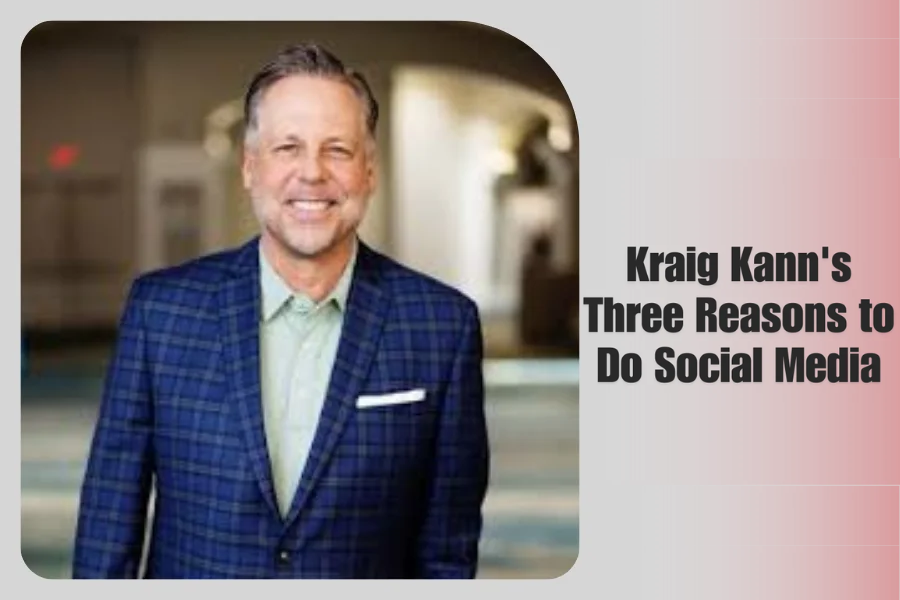Three Good Reasons to Use Social Media, According to Kraig Kann: An Extensive Guide
In today’s digital age, social media has revolutionized how we communicate, share, and interact. What once began as a platform for connecting with friends and family has now become an indispensable tool for businesses. Whether you’re running a small startup or managing a global brand, harnessing the power of social media can give your business a competitive edge. Kraig Kann, a notable expert in this domain, has identified three key reasons businesses should embrace social media. Understanding these reasons can guide you in creating an effective online presence, helping you navigate the complexities of the digital world.
Social media’s benefits extend far beyond posting pictures or announcements. It offers businesses the opportunity to build brand awareness, create authentic connections with their audience, and drive traffic that translates into sales. This guide will delve deep into Kraig Kann’s three reasons to do social media and explore how you can leverage these insights to thrive in the online space.
Reason 1: Building Brand Awareness
Brand awareness is essential in today’s crowded marketplace. With countless businesses vying for consumer attention, standing out from the crowd is crucial. Social media offers a dynamic platform where businesses can showcase their personality, values, and uniqueness.
One of the greatest advantages of social media is its ability to present your brand authentically. Through posts, images, and videos, you can convey your brand’s story in a way that resonates with your audience. Authenticity has become increasingly important as consumers are no longer just looking for products—they seek brands they can connect with on a personal level. Social media offers the perfect avenue for this kind of engagement, allowing businesses to speak directly to their target audience.
Visuals and Engagement: Key Components of Brand Awareness
Effective social media strategies revolve around engaging visuals. Whether it’s eye-catching graphics, high-quality photos, or engaging videos, social media is a highly visual platform. A well-crafted post can capture attention within seconds, especially in an environment where users are constantly scrolling. Additionally, social media encourages interactivity through likes, shares, and comments. Each of these interactions is a micro-endorsement, reinforcing your brand’s presence in the digital landscape.
Utilizing Hashtags for Increased Visibility
Hashtags also play a crucial role in building brand awareness. By using relevant and trending hashtags, businesses can enhance their content’s visibility, reaching users who may not have encountered their brand otherwise. This opens up new avenues for exposure, allowing your brand to be seen by a wider audience. As more users engage with your content, brand recognition increases, laying the foundation for future loyalty.
The ultimate goal of brand awareness is to build familiarity. As people see your posts consistently in their feeds, they begin to recognize your logo, products, or services. Over time, this familiarity can lead to trust, making them more likely to choose your brand when they’re ready to make a purchase.
Reason 2: Connecting with Your Audience and Building Relationships
Beyond brand awareness, social media provides a powerful way to connect with your audience on a deeper level. Building relationships with your customers is essential for long-term success, and social media offers real-time interaction that fosters trust and loyalty.
Two-Way Communication
One of the greatest advantages of social media is its ability to facilitate two-way communication. In the past, businesses would send out marketing messages, and consumers had little opportunity to respond. Social media has flipped this dynamic, allowing customers to directly engage with businesses through comments, direct messages, and even user-generated content. Responding to comments, answering questions, and sharing user-generated content makes your audience feel valued and heard.
This type of interaction is crucial for building customer loyalty. People are more likely to remain loyal to a brand that listens and engages with them. As customers experience personal interaction with your business, they feel a stronger connection, making them more likely to choose your brand over competitors.
Understanding Audience Preferences
Additionally, social media offers insightful information on the tastes and actions of customers. Platforms like Facebook, Instagram, and Twitter offer detailed analytics that allow you to see which types of content resonate most with your audience. This enables you to tailor your future posts to their preferences, creating a more personalized experience for your followers.
For instance, if you notice that your audience engages more with video content, you can create more videos to keep them interested. Similarly, if a particular product receives more attention in your posts, you can highlight it in your marketing campaigns. By consistently offering content that aligns with your audience’s preferences, you build a stronger connection that fosters trust and loyalty.
Building a Community Around Your Brand
Social media allows businesses to cultivate a sense of community around their brand. Through user-generated content, brand hashtags, and interactive campaigns, you can encourage your audience to actively participate in your brand’s story. This sense of community strengthens the bond between your brand and your customers, turning them into brand advocates who are more likely to promote your business to others.
Reason 3: Driving Website Traffic and Boosting Sales
While social media is essential for building brand awareness and connecting with your audience, it also serves as a powerful tool for driving website traffic and increasing sales. With the right strategy, social media can be a gateway to converting followers into paying customers.
Driving Traffic Through Content Sharing
By sharing valuable content and engaging posts on your social media platforms, you can attract potential customers to visit your website. Links in your social media posts act as gateways, leading followers directly to your website where they can learn more about your products or services. The beauty of social media is its vast reach, enabling your posts to be seen by a wide range of users in a short period.
A well-crafted call-to-action (CTA) can guide your followers toward taking specific actions, such as signing up for a newsletter, exploring a product, or making a purchase. For instance, including a “Shop Now” button on an Instagram post or a “Learn More” link in a Facebook post can direct interested users to your website, where they can take the next step in the customer journey.
Social Media Advertising: Reaching Targeted Audiences
Social media advertising provides businesses with an opportunity to reach targeted audiences. Platforms like Facebook, Instagram, and LinkedIn offer advanced targeting options that allow you to create ads tailored to specific demographics, interests, and behaviors. This means your ads are shown to people who are more likely to be interested in your products, increasing the chances of conversion.
For example, if you’re launching a new product, you can create a Facebook ad campaign targeting individuals in a specific age group or location who have previously expressed interest in similar products. These highly targeted campaigns ensure that your marketing efforts are more efficient and effective, ultimately leading to increased sales and revenue.
Retargeting: Bringing Back Potential Customers
One of the most powerful tools in social media advertising is retargeting. Retargeting allows you to show ads to users who have previously visited your website but didn’t make a purchase. By keeping your brand top of mind, retargeting ads can encourage these potential customers to return to your website and complete their purchase.
This strategy is especially effective because it targets individuals who have already shown interest in your products or services, making them more likely to convert. With the right messaging and creative elements, retargeting can significantly boost your sales.
Tips for Crafting an Effective Social Media Strategy
Creating an effective social media strategy requires careful planning and execution. Here are some key tips to help you succeed:
- Define Clear Goals: Before diving into social media, establish what you want to achieve. Whether it’s increasing brand awareness, boosting engagement, or driving sales, having clear goals will guide your strategy.
- Know Your Audience: Understand your audience’s preferences, interests, and pain points. Tailor your content to resonate with them and meet their needs.
- Consistency is Key: Regular posting is essential for maintaining engagement. However, ensure that the content you share is high-quality and aligns with your brand’s messaging.
- Engage Actively: Respond to comments and messages promptly. This not only builds trust but also encourages further interaction with your brand.
- Use Analytics: Monitor your performance metrics to see what content works best. Continuously adjust your strategy based on data insights for improved results.
- Experiment with Content Formats: Keep your audience engaged by experimenting with different content formats like videos, infographics, polls, and stories.
- Hashtag Wisely: Use relevant hashtags to expand your content’s reach. Hashtags can significantly increase visibility and attract new followers when used strategically.
Common Mistakes to Avoid on Social Media
While social media presents incredible opportunities, it’s also important to be mindful of common mistakes that could harm your brand:
- Inconsistent Posting: Inconsistent posting can lead to audience disengagement. Establish a content calendar to maintain regular updates.
- Ignoring Engagement: Failing to respond to comments or messages can result in a loss of trust. Always prioritize engaging with your followers.
- Over-Promotional Content: Social media is about building relationships, not just selling. Strike a balance between promotional posts and valuable, engaging content.
- Neglecting Analytics: Without tracking your performance, you won’t know what works and what doesn’t. Use analytics tools to refine your strategy based on data insights.
Conclusion
Social media is an indispensable tool for businesses today, offering numerous opportunities to grow your brand, connect with your audience, and drive sales. Kraig Kann’s three reasons to do social media—building brand awareness, connecting with your audience, and driving traffic—highlight the importance of a well-crafted social media strategy. By embracing these principles and avoiding common mistakes, you can harness the full potential of social media to propel your business forward.
As you navigate the ever-changing social media landscape, remain adaptable, creative, and authentic. Continuously monitor your performance and adjust your strategy based on what resonates with your audience. With the right approach, social media can become a powerful asset in achieving your business goals.





